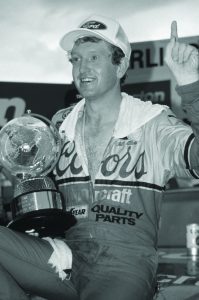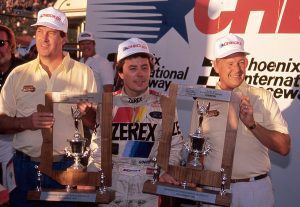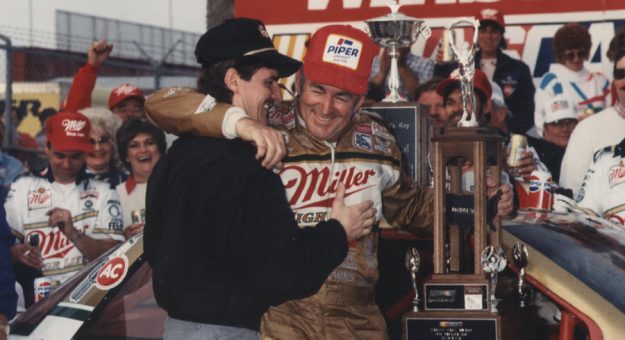Editor’s Note: NASCAR is celebrating its 75th anniversary in 2023. SPEED SPORT was founded in 1934 and was already on its way to becoming America’s Motorsports Authority when NASCAR was formed. As a result, we will bring you Part 41 of a 75-part series on the history of NASCAR as told in the pages of National Speed Sport News and SPEED SPORT Magazine.
If variety is the spice of life, then the 1988 NASCAR Winston Cup season was a stew spiced with cayenne pepper.
Fourteen different drivers, including four first-time winners, visited victory lane, four drivers led the points and two tire companies vied for the advantage before Bill Elliott secured his first championship.
Bobby Allison grabbed the first victory of the season in the Daytona 500 at Daytona lnt’l Speedway. The 50-year-old former champion led his son, Davey, across the finish line in the first father-son, 1-2 finish since Lee and Richard Petty finished 1-2 at Heidelberg (Pa.) Speedway on July 10,1960.
The elder Allison also broke his own record as the oldest Cup Series winner.
The race was the first with smaller one-inch restrictor plates, which were mandated at Daytona and Talladega Superspeedway to reduce speeds, increase competition and safety.
However, after Richard Petty suffered a horrifying accident coming off the fourth tum on the 107th lap. His son, Kyle, blamed restrictor plates for bunching the field and leading to the accident.
“That happened because of the stupid plate,” an emotional Kyle Petty charged in the Feb. 17 issue of National Speed Sport News. “You get a bunch of guys up there who don’t know how to drive race cars.”
Petty was driving 190 mph when Phil Barkdoll tagged him, spinning the No. 43 car and allowing air to lift it into the wall. Petty’s car rolled three times before standing on its nose and rolling twice more. Finally, Brett Bodine hit the STP car and spun it like a top.
Fortunately for “The King,” he suffered no major injuries in the accident and was examined and released from the hospital later the same day.
Hoosier Vs. Goodyear
Neil Bonnett won the next two races, at Richmond (Va.) Raceway and North Carollna Motor Speedway, but the buzz around the garage area was not about Bonnett’s victories.

What made Bonnett’s run so unusual was the tires he used on his Pontiac Gram Prix — Hoosiers. For the first time since the Firestone Tire Co. had withdrawn from NASCAR Winston Cup racing, Goodyear Tire and Rubber Co. had competition.
While most of the top drivers continued to use Goodyear racing tires, they acknowledged Hoosier Tire’s success.
“Hoosier had us beat today,” said Rusty Wallace, who finished 14th at the Rockingham, N.C., track, in the March 9 issue of National Speed Sport News. “I sat there and watched cars that normally don’t run that fast pass me and they all had on Hoosiers.”
“I’d have beaten everybody,” added Elliott. “(But) we were just putting on the wrong brand.”
Hoosiers became the right brand for drivers seeking fewer tire changes because Hoosiers seemed to get faster with use, whereas Goodyears generally started fast, but faded after 40 to 50 laps. This advantage led Goodyear to employ a softer tire compound to increase tire speed, but this led to other problems.
The softer compounds led to greater speeds and more tire failures, which created frequent tire shortages. On the other hand, the harder compounds used by Hoosier often blistered, thereby negating their advantage.
During the 1988 season, most drivers had either tested or raced on both brands, sometimes in the same event.
However, drivers using Goodyear tires won 20 of the 29 Winston Cup races. The final blow to Hoosier’s bid to become part of Winston Cup racing came when Goodyear announced plans to introduce a heartier and faster radial tire at Daytona in 1989. Bias-ply Hoosier did not possess the facilities to produce radial tires.
Earnhardt, Wallace Duel For Championship
Defending Winston Cup champion Dale Earnhardt followed Bonnett’s double play with a dominant performance at Atlanta Motor Speedway, leading 269 of the 328 laps.
Lake Speed avoided an eight-car wreck on lap six and a seven-car crash on lap 17 to win at Darlington (S.C.) Raceway, while Elliott collected his first short-track victory at Bristol (Tenn.) Motor Speedway. It was also the first time in 17 years that a Ford won at the .533-mile track.
Terry Labonte became the sixth different winner in seven races when he won at North Wilkesboro (N.C.) Speedway. Point leader Earnhardt was leading the race until a leaking rear tire forced him to pit with 11 laps remaining.
Earnhardt returned with a vengeance the following week at Martinsville (Va.) Speedway, leading the final 182 laps en route to victory.
Phil Parsons won for the only time in his Winston Cup career at Talladega and 71-time winner Darrell Waltrip added another trophy to his collection with the Coca-Cola 600 victory at Charlotte Motor Speedway. Elliott won for the 25th time in his career, besting the field at Dover Downs Int’l Speedway.
With 11 races in the books, Earnhardt, Wallace and were the focus of the championship chase.
Wallace pushed to the top of the point race with his victory at Riverside (Calif.) lnt’’l Raceway. Wallace’s fifth career victory was also his third straight on a road course. The race also marked the end of 31 years of Winston Cup racing on the 2.631-mile course that was scheduled for demolition.
Wallace maintained the top spot in the points with a third-place finish at Pocono Raceway. Geoff Bodine won the race in which Bobby Allison was critically injured after his spinning car was T-boned by the machine driven by Jocko Maggiacomo.
The 85-time Winston Cup victor and 1983 champion never raced again.
Wallace posted a record 153.55 mph average speed in winning his first superspeedway race on June 29 at Michigan Int’l Speedway. Elliott finished second. Elliott defeated Rick Wilson in a last-lap, paint-swapping duel at Daytona.
Three weeks later, Elliott closed to within three points of Wallace with a victory at Pocono Raceway. Elliott won the race on Hoosier Tires after Goodyear was forced to sit out the race because its tires were .15 inches too wide.
Ken Schrader passed Earnhardt and Sterling Marlin on the final lap to post his first Cup Series victory at Talladega.

Wallace Rubs Fenders At Watkins Glen
Wallace was involved in a fender-rubbing incident at Watkins Glen Int’l.
In the final tum of the last lap around the 2.428-mile road course, Wallace bumped leader Ricky Rudd in an attempt to take the lead. However, Wallace slid off the track as Rudd drove to victory. Elliott finished second and followed Wallace and winner Davey Allison to the checkered flag at Michigan Int’l Speedway, to trail Wallace by only 21 points.
Elliott cut the lead to 16 points at Bristol (Tenn.) Motor Speedway after finishing second to Earnhardt, while Wallace finished ninth in a backup car.Then Elliott made his run. A Southern 500 score at Darlington, a Dover Downs victory and top-10 at Richmond, Martinsville, Charlotte, North Wilkesboro and Rockingham put Elliott 79 points ahead of Wallace with two races remaining.
Yet, Wallace kept the pressure on. He finished second at Darlington, third at Martinsville and won consecutive events in Charlotte, North Wilkesboro and Rockingham to keep the pressure on Elliott.
“It’s like building a sandcastle on the beach,” said Elliott after Wallace’s third straight victory. “The surf just keeps eating away at it. Maybe this point race will be over with before high tide.”
Alan Kulwicki held back the onrushing Wallace at Phoenix lnt’l Raceway as Kulwicki scored his first Winston Cup victory. Elliott’s fourth-place finish and Wallace’s fifth spot put Wallace in the position of having to finish at least 17 spots higher than Elliott in the final race of the season to capture the championship.
Wallace did everything he could, winning the pole and the season finale at Atlanta, but Elliott’s 11th-place finish garnered him the Winston Cup championship.
“I feel relieved now that this is over,” said Elliott, who bested Wallace by 24 points. “It’s like the world is off my shoulders.”
“This is eating away at me,” remarked Wallace. “I was fastest, I led the most laps and I won the race. There was nothing left for me to do.”
“In 1985, the pressure got to me at times,” added Elliott. “Running for the (Winston) Million and the points championship … maybe you have to lose a point title in order to win one.”
Elliott also won the Most Popular Driver award for the fifth consecutive year and Ron Bouchard edged Ernie Irvan for rookie-of-the-year honors. Tommy Ellis was the Busch Grand National champion and Ray Smith won the Winston West title.
For the second consecutive season, Larry Caudill won the Charlotte/Daytona Dash division while Mike McLaughlin became the modified champ. Dave Mader III won the All-American Challenge Series for the fourth consecutive year and Ron Eaton emerged in the Northwest Tour.
